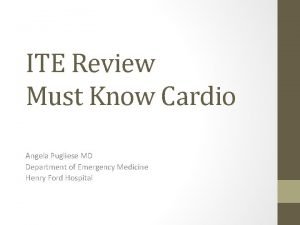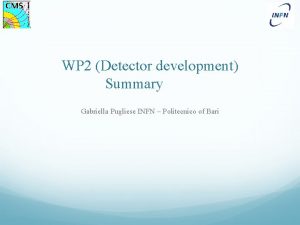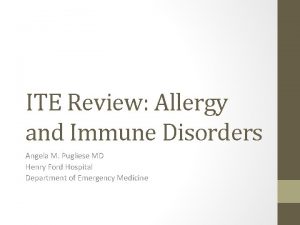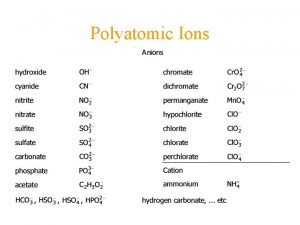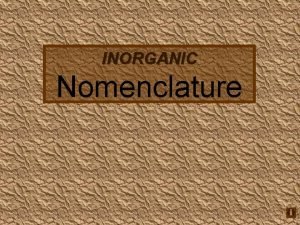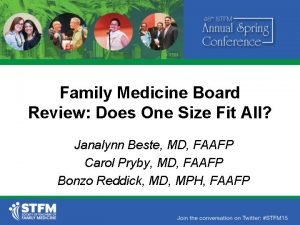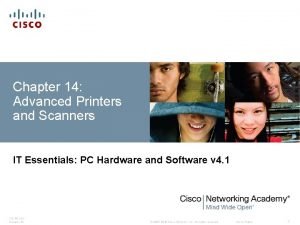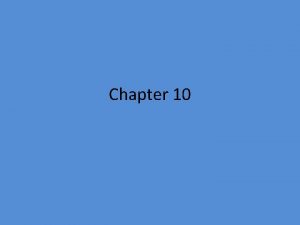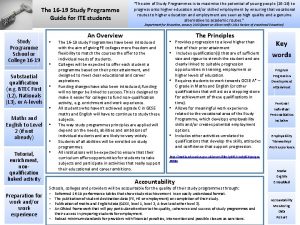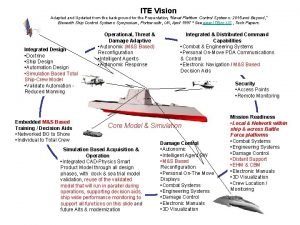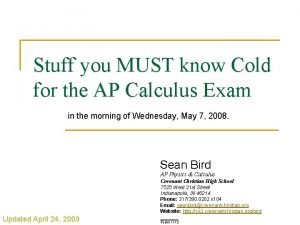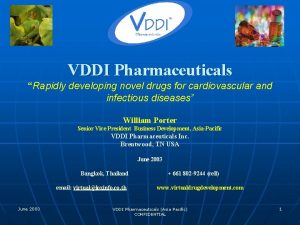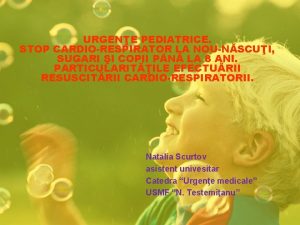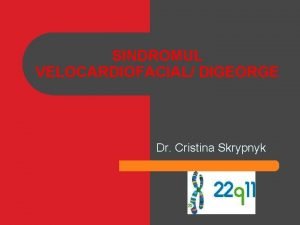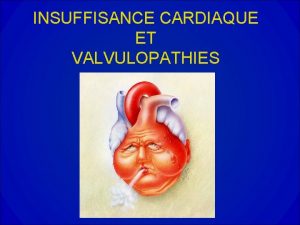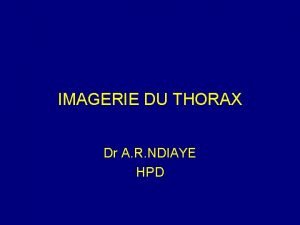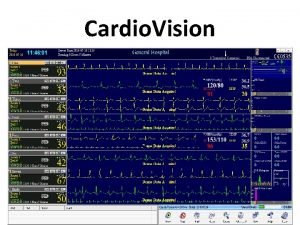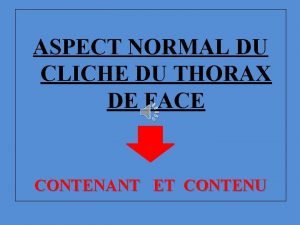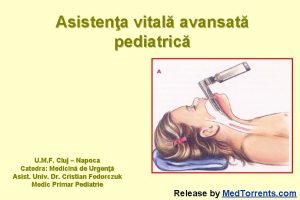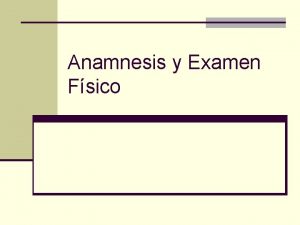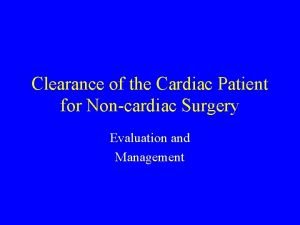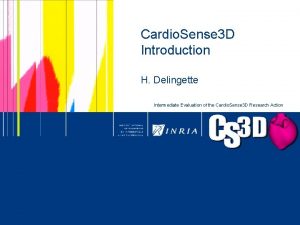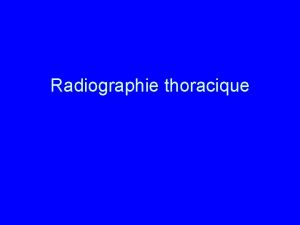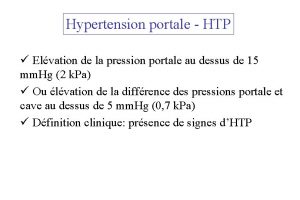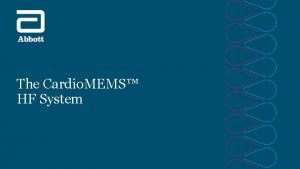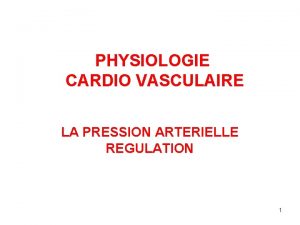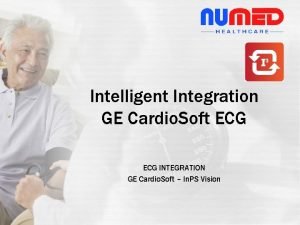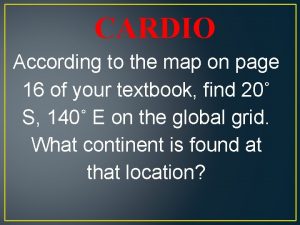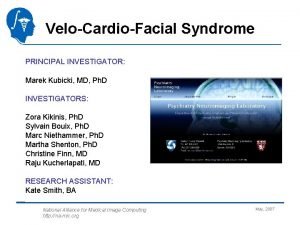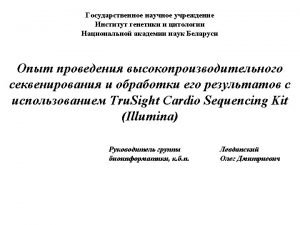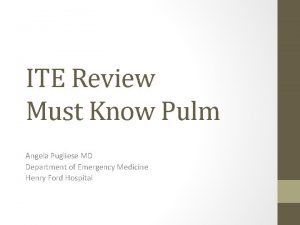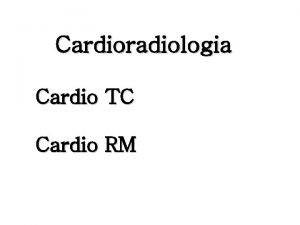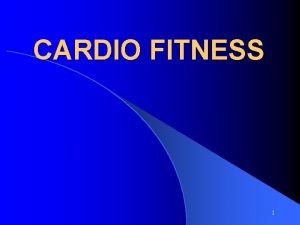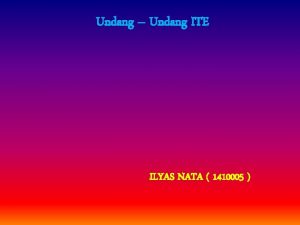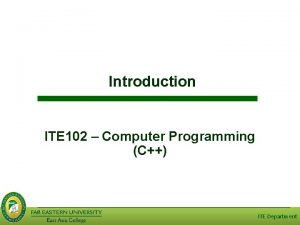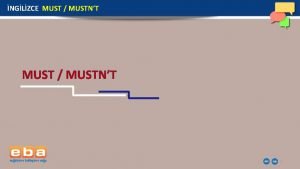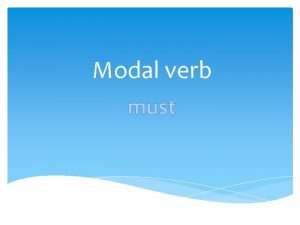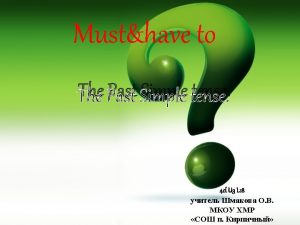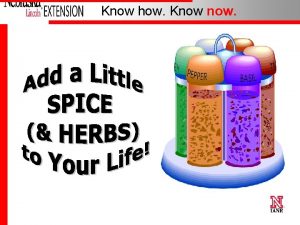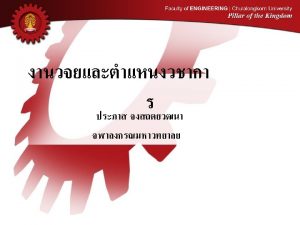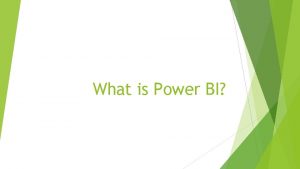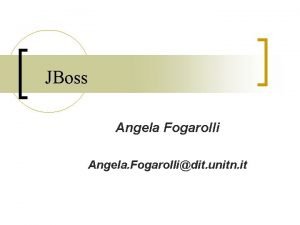ITE Review Must Know Cardio Angela Pugliese MD








































- Slides: 40

ITE Review Must Know Cardio Angela Pugliese MD Department of Emergency Medicine Henry Ford Hospital

Outline • • • Dysrhythmias ACS CHF/Cardiogenic Pulmonary Edema Cardiomyopathies DVT PE Pericardial Disorders Myocarditis/Pericarditis Aortic Dissection/AAA HTN Emergency/Urgency Valvular Heart Disease EKG Trivia

First and Foremost • KNOW ACLS • Meds that can be given through the ET tube - LEAN • • L - lidocaine E - epinephrine A – atropine N – nalaxone • Give 2 times normal dose diluted in normal saline

Dysrhythmias • Always assess hemodynamics……. • SHOCK THE UNSTABLE PATIENT

Dysrhythmias • SVT • Regular • Vagal maneuvers and adenosine • Afib • Irregularly irregular • Normal EF – CA/Beta blockers, Low EF – dig/amiodarone • Think anticoagulation • WPW • Short PR, delta wave • Narrow tx like SVT • Wide procainamide vs amiodarone • A-flutter • Rate control • MAT • Irregularly irregular, p-wave variation 3 types • Treat underlying cause ie COPD/CHF • Avoid beta blockers, think CA block or mag

Dysrhythmias • Sick Sinus Syndrome • Combination brady-tachy arrhythmia • Refer to cardiology for pacer • Vtach • 3 + PVCs with rate >120 • Amiodarone, lidocaine, procainamide • Torsades • Axis swinging from + to – in single lead • Mag and overdrive pacing • Vfib • ACLS

Dysrhythmias • AV Blocks • 1 st – prolonged PR, no treatment if no symptoms • 3 rd – AV dissociation, requires pacing • 2 nd • Mobitz 1 (Wenckebach) • Mobitz 2 – avoid atropine, needs pacing

ACS • Continuum • Angina – Unstable Angina – NSTEMI - STEMI • AMI – STEMI or CP with elevated markers • Treatment – • ASA, plavix, heparin, nitro • Thrombolytics – TPA • Give within 30 minutes if PCA > 60 min away • Complications • Vfib highest in first hour • LV failure • >20 % loss = pulm edema • > 40% loss = shock

CHF/Cardiogenic Pulm Edema • Left sided • Ischemic heart disease, HTN • Aortic/mitral valvular disease • Right sided • Left sided failure, pulm HTN, tricuspid/pulmonic disease • Signs and symptoms • SOB, ‘cardiac asthma’ • Pleural effusions • S 3, JVD, dependent edema

CHF/Cardiogenic Pulm Edema • CXR/Symptom progression • Stage 1 – cephalization, dyspnea • Stage 2 – interstitial edema (kerley B lines), dry cough • Stage 3 – alveolar edema (butterfly pattern), wet cough pink frothy sputum • Lab – BNP <100 excludes • Treatment • • OXYGEN BIPAP Afterload reduction, diuresis Think pressors for shock (dopamine, dobutamine)

Cardiomyopathies • Idiopathic Dilated – most common • Restrictive • Hypertrophic

Dilated Cardiomyopathies • All four chambers, systolic pump failure • Have signs of left and right failure • Afib most common dysrhythmia • Tx – vasodilators, diuretics

Restrictive Cardiomyopathies • Diastolic restrictive of ventricular filling • Mimics constrictive pericarditis • Right sided symptoms predominate • Exercise intolerance • Tx – diuretics, AVOID vasodilators

Hypertrophic Cardiomyopathy • • LVH without dilation (septum greater) 50% inherited DOE, syncope or pre-syncope with exertion Sudden death with exercise induced dysrhythmias • Tx • • Propanolol Avoid increasing myocardial contractility Septal myomectomy for severe cases Abx prophylaxis for dental procedures

DVT • Virchow’s Triad • Venostasis, hypercoagulability, vessel wall injury • Presentation • Unilateral pain, swelling and edema (>3 cm difference) • Diagnosis • Duplex US (repeat testing in 7 days) • Tx • Aimed at preventing PE • Anti-coagulation • Thrombolytics (vascular surgery consult

Cerulea Dolens Alba Dolens

Pulmonary Embolism • Presentation • Dyspnea • Classic triad – dyspnea, pleuritic CP or tachypnea • CXR • Dyspnea, hypoxia and normal are very suggestive • Diagnostics • EKG, d-dimer, V/Q, CT, Angiography • Tx – • Anticoagulation • Thrombolytics • Hemodynamic instability • TPA, 100 mg over 2 hours

PE – CXR Findings

PE - Diagnostics • EKG – sinus tach most common • S 1, Q 3, T 3 • D-dimer – know Well’s, low risk pt only • V/Q • Limited in lung disease • Needs clinical context • Low-mod pretest prob with normal study 98% exculsion • CTA • 95% sensitive for segmental or large PE, 75% for subsegmental • Angiography • Gold standard

Pericardial Disorders • Pericarditis • Idiopathic and viral most common causes • Diagnosis • • • Hx – sharp precordial pain relieved by sitting up and leaning forward PE – friction rub EKG – diffuse concave ST elevation, PR depression Echo – to look for effusion BUN/Crt – look for uremia • Treatment • Outpatient NSAID for idiopathic/viral and reliable pts

Pericardial Disorders • Pericardial Tamponade • Becks Triad – hypotension, JVD, muffled heart tones • Tachycardia is earliest finding • Diagnosis • EKG – electrical alternans, low voltage • Echo – gold standard, large effusion, diastolic RV collapse • Treatment • Monitor, IV, O 2 • Aggressive volume resuscitation and pressors if needed • Cardio/CT surgery consult and pericardiocentesis (under US)

Myocarditis • Presentation • Range from non specific fatigue to florid CHF • Watch for tachycardia out of proportion to fever • Diagnosis • Echo – dilated chambers with diffuse or focal hypokinesis • Labs – elevated ESR, trop rise and fall slowly • Biopsy for definitive • Etiology • Viral most common cause • Treatment • Supportive, treat like CHF • Avoid immunosuppressives and NSAIDs • IVIG for Kawasaki

Endocarditis • Localized infection of endocardium with hallmark vegetation • Causative Organisms • Native valve – non-viridan strep • Prosthetic valve – coag-neg strep (<60 day post op) • IVDA – staph aureus (found on right, ie pulmonic) • Presentation • Fever most common finding • Signs of metastatic infection • • Roth spots Splinter hemorrhages Osler nodes – TENDER nodules on volar fingers Janeway lesions – non tender macules on fingers, palms, soles

Endocarditis • Diagnosis • Positive blood cultures • Duke criteria • Treatment • Native valve – ampicillin + gent or vanc + gent • Prosthetic – vanc + gent + rifampin

Duke Criteria • Major • Positive blood culture • Evidence of endocardial involvement (TEE) • Minor • • • Predisposition Fever Vascular and/or immunologic phenomenon Microbiology evidence Echo evidence • Need 2 major or 1 major with 3 minor or 5 minor

Endocarditis Prophylaxis • Needed for procedures with significant manipulation of infected tissue • Not needed for foley, intubation, routine dental cleaning • • • Prosthetic valve Hx of endocarditis Cyanotic congenital heart lesions Acquired valvular disease (ie rheumatic fever) Hypertrophic cardiomyopathy

Aortic Dissection • Males age 50 -70 • HTN most common risk factor • Presentation • pain • Classification – type A vs B • Definitive Testing – • TEE – unstable patients • CTA – may miss rapid moving flap • Treatment – • 10 -15 units of blood on standby with surgical consultation • Control HR and BP, esmolol first then nipride • Treat pain with IV narcotics

Aortic Dissection • EKG – • Usually abnormal • STEMI most common misdiagnosis (inferior) • CXR findings • Widened mediastinum • Right side • Tracheal deviation • Left side • Apical cap • Effusion • Depressed mainstem bronchus

Expanding/Ruptured AAA • > 95 % infrarenal • Males > 60 • Presentation • Thing middle age male with syncope or near syncope and lower abdominal or back pain • PE classic pulsatile abdominal mass • Diagnosis and Management • • Bedside echo IV, O 2, monitor 10 units of blood on standby Surgical consultation

HTN Emergency/Urgency • End Organ Damage • DBP > 115 • Arrest and lower BP rapidly, 30% in first hour • Asymptomatic pt discharge to follow up with PCP • Oral agents to lower BP over 24 -48 hours

Valvular Disorders

Mitral Valve Prolapse • Click murmur syndrome • High pitched late systolic murmur with mid-systolic click • Most common – 5 -10% of population • Presentation • Young women – palpitations • Elderly – syncope • Treatment • Only symptomatic pts • Beta blockers for CP or dysrhythmias • ASA or anticoagulation with hx TIA/stroke

Mitral Regurgitation • Acute • • Rupture chordae tendineae or papillary muscle after… Presents with fulminant CHF Apical systolic murmur Tx- hemodynamic support and CT surgery consult • Chronic • • Evolves slowly and usually coexists with mitral stenosis High pitched holosystolic murmur Afib in 75% of patients Abx prophylaxis

Aortic Stenosis • Etiology • <65 bicuspid valve • >65 calcification • Symptoms • Exertional dyspnea or syncope • Harsh crescendo-decrescendo murmur radiating to carotids • Treatment • Mild – d/c home avoid strenuous activity • CHF – admit, reduce preload/afterload • Refer all symptomatic patients for surgical therapy

EKG Trivia

EKG & Electrolytes, etc. • • • Hypothermia = ‘J wave’ or osborn wave Sinus brady an afib w/out RVR Hypokalemia = Prolonged QT Also seen in hypomag Hyperkalemia = Peaked T’s (5. 5 -6. 5) Prolonged PR, flattened p’s, wide QRS (6. 5 -8) Sine wave, vfib, asystole (>8) Hypocalcemia = Prolonged QT

EKG & Electrolytes, etc • Hypercalcemia = • shortened ST and QT intervals • Narrow QRS • Digitalis = • Sagging ST, concave up • Treatment – multiple dose charcoal and FAB



The END
 Angela pugliese
Angela pugliese Creativity creative acrostic poem
Creativity creative acrostic poem Gabriella chierici wikipedia
Gabriella chierici wikipedia Dr pugliese allergist
Dr pugliese allergist Praise points ite
Praise points ite Ti3n compound name
Ti3n compound name Ate ite ide chart
Ate ite ide chart Dr janalynn beste
Dr janalynn beste Ite chapter 14
Ite chapter 14 Ate ite ide chart
Ate ite ide chart Ite programme
Ite programme Ite osi
Ite osi Ite vision
Ite vision Ite bully
Ite bully Ite ceccano
Ite ceccano Types of network communication
Types of network communication Know history know self
Know history know self Normalizing flow
Normalizing flow God of angel armies
God of angel armies Stuff you must know cold calculus bc
Stuff you must know cold calculus bc Vddi cardio
Vddi cardio Semnele stopului cardiorespirator
Semnele stopului cardiorespirator Sindromul velo-cardio-facial
Sindromul velo-cardio-facial Nébilox
Nébilox Signe de l'iceberg radio
Signe de l'iceberg radio Hila lung
Hila lung Cardiovision
Cardiovision Index cardio thoracique
Index cardio thoracique Cauze reversibile de stop cardio-respirator
Cauze reversibile de stop cardio-respirator Normocraneo
Normocraneo Cardio clearance meaning
Cardio clearance meaning Cardio sense
Cardio sense Index cardiothoracique
Index cardiothoracique Sufijo gonia
Sufijo gonia Gastropathie en mosaïque
Gastropathie en mosaïque Pa cardio
Pa cardio Tonus cardio moderateur
Tonus cardio moderateur кардио софт
кардио софт Cardio map
Cardio map Investigator photos
Investigator photos Trusight cardio
Trusight cardio
